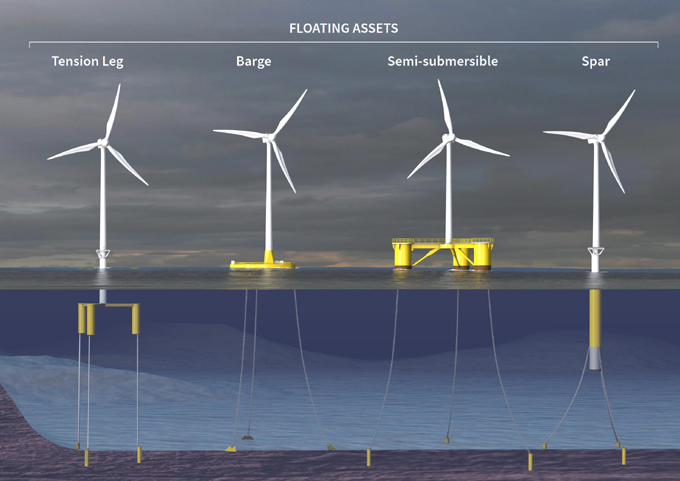Approximately 80% of the foundations installed worldwide today are monopiles. They offer several key advantages over other foundation types, such as simple design, serial fabrication and well-established transportation and installation procedures. However, in coming years, as wind farms expand into deeper waters (> 40m) with heavier turbines (10MW and beyond), foundations will also have to increase in size to offset the resulting increases in overturning moment. The overturning moment for a 15MW turbine, for example, more than doubles in comparison to a 10MW turbine; and the overturning moment of a 10MW turbine increases by 35% in 60m water depth compared to 20m.

This all introduces new challenges surrounding fabrication, materials, transportation, installation, supply chain and environmental impact. As a result, foundation selection is becoming increasingly development specific. But how exactly do you select the right foundation type? In this blog, Luiza Ferrera, Senior Engineer at 2H Offshore, the lead brand in Acteon’s Offshore Engineering segment, explains a method to help weigh up all the relevant factors to make the best choice.
A CONCEPT-SCREENING APPROACH FOR FIXED WIND FOUNDATION FEASIBILITY
Selecting a wind turbine foundation is an extremely complex decision that must consider many factors, from fabrication, installation, operation and environmental impact, to the levelised cost of energy (LCOE) over the life cycle of the project (i.e. integrity management, life extension and decommissioning).
The main configurations of bottom fixed foundations that we typically assess in our concept-screening approach are:
- Gravity base
- Suction bucket monopile
- Monopile
- Tripod
- Jacket
Our assessment uses a risk-based scoring matrix aiming for independence and transparency to ensure that the most appropriate solution is reached. It considers the following parameters at a minimum, but can be customised to specific requirements:
- Design
- Manufacturability
- Transportation
- Installation
- Environmental impact
- Operation and IMMR (inspection, monitoring, maintenance and repair)
- Decommissioning
The above parameters are also expanded into subcategories, for example, “duration” and “cost”. Each parameter is evaluated separately and pertinent details are noted.
The rating system for each sub-parameter is scaled from 1 to 7. Lower scores mean that the foundation is more cost-effective and/or has a higher technology readiness level (TRL). Higher scores represent structures that are less cost-effective and/or have a lower TRL and consequently represent higher risk.

Parameters are also given a weighting factor to represent their importance of the overall scoring. The weighting factor can be highly impacted by regional constraints since wind markets, supply chains and regulations can vary significantly from region to region. To define the weighting factor, we assess the following for the region in question:
- Regional regulatory requirements
- Project scale – number of wind turbine generators (WTG), WTG size and array
- Geotechnical and metocean conditions
- Local supply chain
- Other factors that can impact the weighting factor are variations of water depth and geotechnical characteristics across the wind farm site which, if not available, can lead to uncertainties.
THE SCREENING PROCESS
With the foundation types, parameters and weighting factors defined, a scoring matrix is completed in two steps:
In step one, rates from 1 to 7 are assigned to each foundation type against each parameter and/ or sub-parameter to show how a foundation type compares to the others.
In step two, the weighting factor is applied to the average rate from all sub-parameters of the same parameter. This will summarise the results, accounting for the rates and weighting factors, and will indicate the foundations that offer the best solution for the specific site under assessment.
The screening results could also indicate that more than one solution is recommended for the wind farm if factors such as soil properties and water depth vary across the site.
SUMMARY
The screening process of fixed wind foundations is complex and the amount of research and expertise that goes into defining the weightings and determining the scores can be significant. To achieve an accurate and thorough assessment, it is critical to understand the full life cycle and to thoroughly analyse all seven parameters mentioned above. Through 2H Offshore, Acteon can provide this high-level technical expertise. Acteon is also independent of vessels or concepts, which allows for practical efficiency and adaptability to each project’s circumstances.
As the industry deploys larger turbines, in deeper water, across a wider range of geotechnical and regulatory domains, the need to select optimal foundations becomes increasingly important. Choosing the right foundation to minimize cost and risk to the offshore wind farm and the environment is critical to a successful development and to achieving a low LCOE.
KeyFacts Energy Industry Directory: Acteon
 KEYFACT Energy
KEYFACT Energy